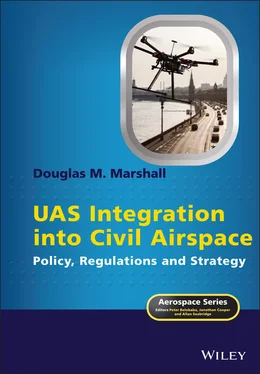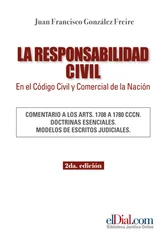Library of Congress Cataloging-in-Publication Data Hardback: 9781118339497 ePDF: 9781118536599 ePub: 9781118536582 oBook: 9781118536575
Cover image: © windjunkie/Getty images
Cover design by Wiley
Set in 9.5/12.5pt STIXTwoText by Integra software servives Pvt Ltd., Pondicherry, India
1 Cover
2 Series page
3 Title page
4 Copyright
5 Preface
6 Aerospace Series Preface
7 Acknowledgements
8 List of Acronyms and Abbreviations
9 1 Background IntroductionSetting the Stage for Integration of Remotely Piloted Aircraft into Non-segregated AirspaceThe Law of the Sea and the Law of the AirA Brief History of Aviation RegulationsInternational Civil Aviation RegulationsThe Chicago Convention and the International Civil Aviation OrganizationConclusionReferences
10 2 UAS Airspace Integration in the European Union Regulations, Opinions, DecisionsImplementing OrganizationsEurocontrolConclusionReferences
11 3 ICAO ICAO Model UAS RegulationsAdvisory CircularsDRAFT Canada AC 922-001, RPAS Safety AssuranceUTM GuidanceICAO RPAS Concept of OperationsICAO U-AID GuidanceThe ICAO UAS ToolkitRPAS Manual (Doc.) 10019 1 stEditionConclusionReferences
12 4 UAS Airspace Integration in the United States The FAA Modernization and Reform Act of 2012 (Hereafter FMRA), Public Law 112-95, Title III – Safety, Subtitle B – Unmanned Aircraft SystemsThe FAA Extension, Safety, and Security Act of 2016 Title II, Subtitle B-UAS Safety (Pub. L. 114-190)The FAA Reauthorization Act of 2018 (Pub. L. 115-254)The Response from the FAA and NASAStatus of UTM TodayUTM VisionParticipationPerformance AuthorizationsAirspace AuthorizationRecent Developments in UAM/AAMConclusionReferences
13 5 Global Airspace Integration Activities AustraliaBrazilCanadaChinaFranceGermanyIrelandItalyJapanMexicoNetherlandsNew ZealandNorwaySingaporeSouth AfricaSwedenUnited KingdomConclusionReferences
14 6 The Role of Standards ConclusionReferences
15 7 The Technology ConclusionReferences
16 8 Cybersecurity and Cyber Resilience Describing the ThreatICAOIATFGlobal Resilient Aviation Network Concept of Operations – Trust FrameworkICAO Council and Assembly DocumentsDeclaration on Cybersecurity in Civil Aviation (Dubai, 2017)ConclusionReferences
17 Index
18 End User License Agreement
1 Chapter 4Figure 4.1 Drones in flight in downtown Reno, Nevada,...Figure 4.2 UTM system managing various commercial,...Figure 4.3 Future airspace management domains to...Figure 4.4 FAA Next Gen Notional UTM Architecture...Figure 4.5 UTM Ecosystem (FAA website). A full-colour...Figure 4.6 UPP High-level Operational Concept...
1 Cover
2 series page
3 Title page
4 Copyright
5 Table of Contents
6 Preface
7 Aerospace Series Preface
8 Acknowledgements
9 List of Acronyms and Abbreviations
10 Begin Reading
11 Index
12 End User License Agreement
1 i
2 ii
3 iii
4 iv
5 v
6 vi
7 vi
8 vii
9 viii
10 ix
11 x
12 xi
13 xii
14 xiii
15 xiv
16 xv
17 xvi
18 xvii
19 xviii
20 xix
21 xx
22 xxi
23 xxii
24 xxiii
25 xxiv
26 xxv
27 xxvi
28 1
29 2
30 3
31 4
32 5
33 6
34 7
35 8
36 9
37 10
38 11
39 12
40 13
41 14
42 15
43 16
44 17
45 18
46 19
47 20
48 21
49 22
50 23
51 24
52 25
53 26
54 27
55 28
56 29
57 30
58 31
59 32
60 33
61 34
62 35
63 36
64 37
65 38
66 39
67 40
68 41
69 42
70 43
71 44
72 45
73 46
74 47
75 48
76 49
77 50
78 51
79 52
80 53
81 54
82 55
83 56
84 57
85 58
86 59
87 60
88 61
89 62
90 63
91 64
92 65
93 66
94 67
95 68
96 69
97 70
98 71
99 72
100 73
101 74
102 75
103 76
104 77
105 78
106 79
107 80
108 81
109 82
110 83
111 84
112 85
113 86
114 87
115 88
116 89
117 90
118 91
119 92
120 93
121 94
122 95
123 96
124 97
125 98
126 99
127 100
128 101
129 102
130 103
131 104
132 105
133 106
134 107
135 108
136 109
137 110
138 111
139 112
140 113
141 114
142 115
143 116
144 117
145 118
146 119
147 120
148 121
149 122
150 123
151 124
152 125
153 126
154 127
155 128
156 129
157 130
158 131
159 132
160 133
161 134
162 135
163 136
164 137
165 138
166 139
167 140
168 141
169 142
170 143
171 144
172 145
173 146
174 147
175 148
176 149
177 150
178 151
179 152
180 153
181 154
182 155
183 156
184 157
185 158
186 159
187 160
188 161
189 162
190 163
191 164
192 165
193 166
194 167
195 168
196 169
197 170
198 171
199 172
200 173
201 174
202 175
203 176
204 177
205 178
206 179
207 180
208 181
In early 2009 Fred Smith, founder, chairman and CEO of the venerable cargo airline, FedEx, declared in an interview that he would like to switch the FedEx fleet to unmanned aircraft as soon as possible, but would have to wait for the FAA to sort out the rules for national airspace integration. In his view, unmanned cargo freighters offer many advantages for his company, predicting that they would be safer, cheaper, and would boast a greater capacity. The result would be a reduction of airfreight prices from ten times the cost of surface-carried freight to a factor of two, with all the speed advantages of air over ground or ocean transportation. Smith pointed out that the modern version of the Boeing 777 is already capable of being operated unmanned, in that the aircraft can take off, fly, navigate, and land without human intervention (and could even be equipped with an autonomous ground guidance system so the aircraft can be “driven” around an airport environment without running into or over someone or something). The same is true of most of the newest passenger aircraft types. The cost savings would derive from the fact that even a single-pilot aircraft requires a completely different design, with radically different economics and logistics. Smith might characterize the economic opportunity as “unused capacity,” or what can be removed from the airplane that would allow an increased load. Systems such as oxygen, pressurization system, lavatories, extra seats, gallies, all intended for the comfort of the crew, can be eliminated and replaced with revenue-generating non-breathing cargo. The concept is not a pipe dream. Northrop Grumman’s Global Hawk reconnaissance aircraft, which is the size of a small business jet, has been flying entirely autonomous missions for several years, meaning that the aircraft is capable of taxing to the runway, taking off, executing its flight plan, and landing at its intended destination without any human intervention.
Читать дальше












